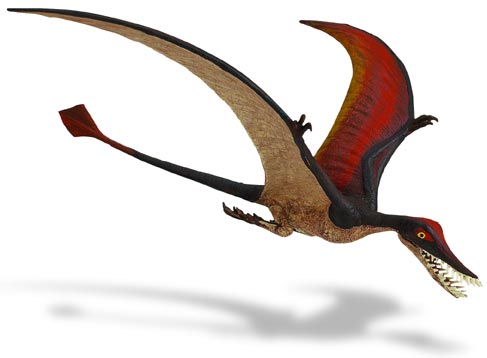Thoughts on Rhamphorhynchus
Rhamphorhynchus – A Popular Pterosaur
Of all the pterosaur models that Everything Dinosaur sells, the Rhamphorhynchus replica which is part of the Wild Safari Dinos Prehistoric Life range, is one of the most popular. Introduced in 2010, this long-tailed member of the Pterosauria has steadily grown in popularity with dinosaur fans and model collectors alike.
Everything Dinosaur’s Illustration of the Wild Safari Dinos Rhamphorhynchus Model
Picture credit: Everything Dinosaur
To view the Wild Safari Dinos range of prehistoric animal models and replicas: Wild Safari Prehistoric World Figures.
Studying the Brain Morphology of Pterosaurs
In 2003, a team of researchers lead by Lawrence Witmer (professor at Ohio University), looked into the fossil evidence in a bid to map the brain anatomy of several types of pterosaurs. One of the flying reptiles studied, due to the quantity of fossils was Rhamphorhynchus muensteri. Using endocasts of the brain they retrieved by performing CAT scans of fossil skulls and by comparing these scans with extant flying animals, the scientists were able to estimate the various physical attributes of members of the Pterosauria so that their flying abilities could be assessed.
Witmer and his team found that Rhamphorhynchus held its head parallel to the ground due to the orientation of the osseous labyrinth of the inner ear, which helps animals detect balance. In contrast, pterodactyloid pterosaurs such as Anhanguera appear to have normally held their heads at a downward angle, both in during flying and whilst on the ground.
Marine Clays of Southern England
Rhamphorhynchus fossils have been recovered from Jurassic marine clays in southern England but the finest and best preserved specimens come from the famous Solnhofen quarry in Bavaria, (southern Germany). Many of these fossils not only preserve the bones but also show impressions of soft tissues such as the wings and tail. Ironically, the Messel oil shale beds and their Eocene fossils are a UNESCO World Heritage site (granted this status in 1995), but as far as we at Everything Dinosaur know, the Solnhofen quarries have not be granted this status.
The Popular Wild Safari Dinos Rhamphorhynchus Model
Picture credit: Everything Dinosaur
Rhamphorhynchus – Flying Reptile
Rhamphorhynchus was a long-tailed type of flying reptile and several species have been described. The wings were made of skin stretched between an elongated finger from its hand, down to the ankle. It had a long, straight tail stiffened with ligaments which ended in a diamond-shaped rudder. It is believed that one of the ways Rhamphorhynchus hunted was by dragging its beak in the water . When it came into contact with prey, it would snap its needle-sharp teeth shut, and toss the food into its throat pouch, a structure that has actually been preserved in some rare fossils. Palaeontologists still debate how this Jurassic reptile fed.
Visit Everything Dinosaur’s website: Everything Dinosaur.



